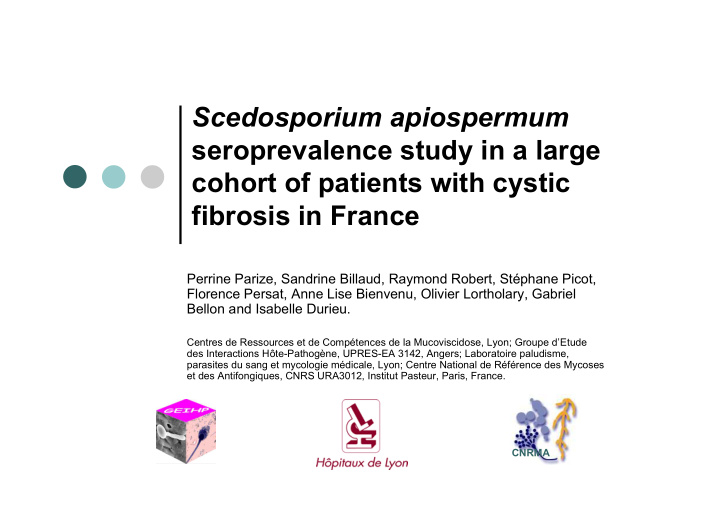



Scedosporium apiospermum seroprevalence study in a large cohort of patients with cystic fibrosis in France Perrine Parize, Sandrine Billaud, Raymond Robert, Stéphane Picot, Florence Persat, Anne Lise Bienvenu, Olivier Lortholary, Gabriel Bellon and Isabelle Durieu. Centres de Ressources et de Compétences de la Mucoviscidose, Lyon; Groupe d’Etude des Interactions Hôte-Pathogène, UPRES-EA 3142, Angers; Laboratoire paludisme, parasites du sang et mycologie médicale, Lyon; Centre National de Référence des Mycoses et des Antifongiques, CNRS URA3012, Institut Pasteur, Paris, France. CNRMA
Scedosporium apiospermum initially considered as the anamorph of Pseudallescheria boydii ubiquitous saprophytic filamentous fungus culture : floccose colonies initially white, becoming dark gray microscopic features of the anamorph state - hyaline and septate vegetative hyphae - anellidic conidiogenesis producing oval, brown, unicellular conidia
Clinical manifestations emerging fungal pathogen large spectrum of clinical manifestations : -mycetoma -sinopulmonary infections (necrotizing pneumonia, sinusitis) -osteomyelitis, septic arthritis -brain abscess -ocular infections -disseminated infections in immunocompromised hosts
S. apiospermum and Cystic Fibrosis Clinical manifestations in cystic fibrosis patients : colonization Cimon et al, Eur J Clin Microbiol Infect Dis 2000 allergic bronchopulmonary mycosis endobronchitis Vazquez-Tsuji et al, Rev Iberoam Micol 2006 spondylitis Guignard et al, J Cyst Fibros 2008 disseminated infection Symoens et al, J Heart Lung Transplant 2006 Sahi et al, J Heart Lung Transplant 2007 Cooley et al, Emerg Infect Dis 2007
Problematics emerging pathogen severity of the infection with frequently a fatal outcome in patients with lung transplantation few epidemiological data many questions about colonization by S. apiospermum : - prognostic factor for unfavorable outcome ? - frequency of invasive infections ? - management of colonized patients ? - preemptive strategy ?
Study Objectives Main Objective : estimate S. apiospermum seroprevalence in a group of pediatric and adult patients with cystic fibrosis Secondary Objectives : study the age-prevalence profiles compare clinical and paraclinical data of S. apiospermum seronegative and seropositive patients evaluate the correlation between S. apiospermum serology and mycological findings of sputum samples
Patients Group of 499 pediatric and adult patients with cystic fibrosis in Lyon, France 256 children - median age 9 [0,17] 177 adults - median age 25 [18,53] sex ratio =1.1 Inclusion criteria - patient is a pediatric or adult CF patient - patient has a serum sample collected during 2008 and stored in the hospital mycological laboratory serum bank Exclusion criteria - patient did not give his consent to the use of his serum sample for the study
Materials and methods Clinical and paraclinical data extracted from electronic file of each patient age, gender, age at CF diagnosis, CFTR genotype in 2008 : - weight, size - respiratory functional parameters - number of acute respiratory exacerbations - duration of hospital stay - courses of antibiotic and antifungal agents - findings of sputum expectorations - results of Aspergillus spp. serology
Materials and methods Serum collection serums selected from a serum bank located in the laboratory of mycology of Lyon University hospital serum used to determine Aspergillus spp. serology for serological follow up of patients all samples collected during the same period (2008) and only one per patient anonymisation of serums and transportation to Angers
Materials and methods S. apiospermum serology Two serological techniques : ELISA using a mix of polysaccharide and protein antigens extracted by mechanical disuruption using glass beads, and corresponding mainly to cytosolic antigens ELISA before and after adsorption with Aspergillus fumigatus antigen confirmatory technique by counterimmunoelectrophoresis and/or western blot to identify specific bands
Perspectives present work : transversal epidemiological study of S. apiospermum colonization in CF patients futur study : prospective cohort study of cystic fibrosis patients with colonization of the respiratory tract and/or positive S. apiospermum serology study of the pathogenicity of S. apiospermum guidelines for the management of patients with cystic fibrosis colonized by S. apiospermum .
Acknowledgment Contribution to the project Centres de Ressources et de Compétences de la Mucoviscidose, Lyon Groupe d’Etude des Interactions Hôte-Parasite, UPRES-EA 3142, Angers Laboratoire paludisme, parasites du sang et mycologie médicale, Lyon Pôle Information Médicale Evaluation Recherche - Lyon Centre National de Référence des Mycoses et des Antifongiques, CNRS URA3012, Institut Pasteur, Paris, France.
Recommend
More recommend